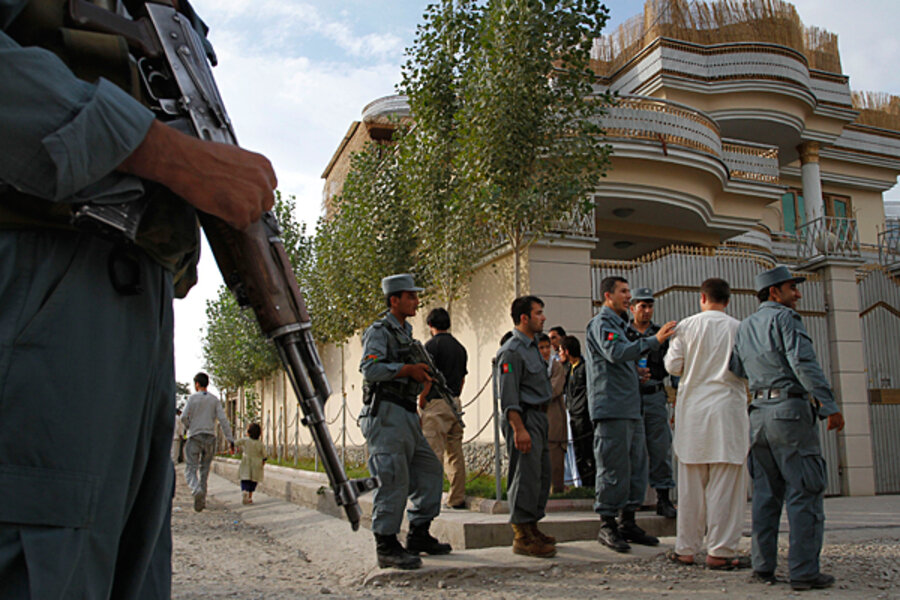Afghanistan war: UN report blames insurgents for rise in civilian deaths
Loading...
| New Delhi
Civilian casualties have surged over the past six months in Afghanistan. According to a new report from the United Nations, it’s the insurgents who are mostly responsible, not the coalition. Gen. David Petraeus has directed NATO to take advantage of this with a new public relations offensive in an effort to win the public relations war.
According to the UN, the number of civilians killed in the conflict in the first half of this year numbered 1,271, more than a 20 percent jump over the same period last year. Under stricter rules of engagement, coalition forces reduced civilian killings by 29 percent, while insurgents killed 48 percent more civilians than at the same time last year. Overall, insurgents were responsible for 72 percent of this year's civilian deaths.
NATO’s tighter rules of engagement have resulted in grumbling in the ranks, but Petraeus hasn’t changed the rules much since he took command in July. Instead, he is pushing his public affairs officers to reap greater benefits from the Taliban’s increasingly poor record on killing innocents.
“He has made it very clear from the beginning that it’s his intent to hold the Taliban accountable for what they are doing – and to announce what they are doing,” says Lt. Col. John Dorrian, the public affairs team chief for international coalition forces.
Beginning in July, Dorrian’s team started sending out more press releases detailing Taliban atrocities. That resulted in 231 press releases that made it to the e-mail inboxes of journalists in July, compared with 130 in June. More releases are also being translated into Afghan languages in the hopes of having more influence on Afghan press coverage of the war.
Dorrian says that within Afghanistan, the coalition was “probably” losing the PR war. By not publicizing attacks committed by the Taliban, the militants would sometimes blame the coalition first, he says.
The Taliban's weakness
The raw material for war propaganda appears to favor the coalition – not just in comparative data from sources like the UN, but in ability to gather information and broadcast it.
“We know the Taliban will be unable to match the level of detail with which we can report in this country. They do not have freedom of movement,” says Dorrian. “This is an enemy weakness that will continue to get weaker, and we will continue to make sure that people are aware of what the Taliban are doing.”
Both sides of the conflict have taken serious hits recently over civilian casualties. The Wikileaks release of classified material from 2009 and earlier revealed a number of civilian casualties caused by the coalition that had gone unreported. (A UN spokesman says his agency’s data do not rely on military reporting but a variety of sources, though it is a reminder that killings do go unnoticed in these data sets.)
And then there's the medical aid worker killings
The Taliban, meanwhile, face a PR debacle over Thursday’s massacre of 10 medical aid workers – a crime claimed by the Taliban. In another case, Afghan police say the Taliban beat and executed a pregnant widow Sunday for alleged adultery – a charge the Taliban denies.
When it comes to civilian casualties in the fog of war, analysts have pointed out that the coalition pays a far steeper price for each killing than does the Taliban. When the coalition kills a civilian, more Afghans are alienated from the government. When the Taliban kill a civilian, Afghans also get angry at the government’s inability to protect them.
Taliban leaders have issued two codes of conducts in as many years, each time urging followers to avoid civilian casualties. The initial code was released just prior to the UN casualty reporting – as was this year’s update. The 2010 UN data indicate that Taliban fighters ignored the initial directives to minimize civilian casualties.
It’s not clear if the codes are understood to be propaganda only, or if the Taliban leadership simply does not have such sway over fighters in the field.
The coalition released what they claim to be an intercepted message from Taliban leader Mullah Omar in which he calls for the killing of any Afghan supporting or working for coalition forces.
Dorrian says that, anecdotally, there appears to be an increase of coverage in the Afghan press of Taliban civilian killings, in part because of the coalition’s new strategy: “You are starting to see a higher level of criticism of the Taliban, and that has effect.”





